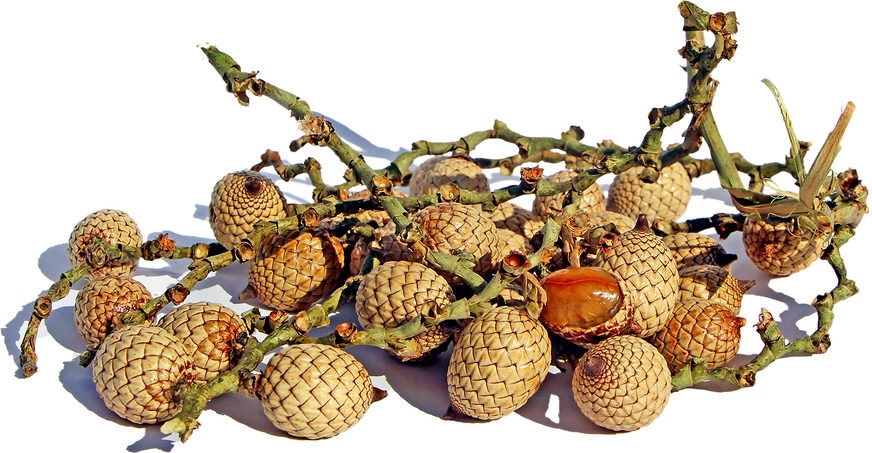


Rattan Fruit
Estimated Inventory, lb : 0
Description/Taste
Rattan Fruit is similar in size to a hazelnut, spanning 1 to 2.5 centimeters in diameter. Its color palette echoes that of a pineapple, featuring shades of orange, yellow, brown, and white. The texture of Rattan Fruit resembles a tiny pinecone, enveloped in a soft, woody skin with overlapping scales arranged in vertical rows. The fruit encases a cream-colored, watery pulp, akin to that of a rambutan, which envelops one to three dark, round seeds. While it lacks a distinctive aroma, Rattan Fruit emits subtle earthy or woody notes, a nod to its natural, fibrous texture. The pulp itself offers a complex, intensely acidic, and surprisingly sour flavor.
Seasons/Availability
Rattan Fruit is available year-round in its native regions.
Current Facts
Also known as Cane Fruit, Rattan Fruit grows on the Rattan palm tree, an evergreen climber scientifically recognized as part of the Calamus genus. Among nearly 650 species of rattan, approximately 14 varieties found in the wild are identified as Calamus flagellum, Calamus floribundus, and Calamus erectus. The Rattan palm is primarily celebrated for its use in crafting furniture. For certain non-climbing species, the stems are utilized whole or cut for creating handles, rods, and walking canes. The vibrant hues of Rattan Fruit attract birds and primates, who play a pivotal role in dispersing rattan seeds.
Nutritional Value
Traditionally embraced by the indigenous tribes of Asia as a functional food, Rattan Fruit is celebrated for its rich composition of proteins, carbohydrates, minerals, and dietary fiber. Its notable content of potassium and pectin plays a supportive role in heart health, digestive well-being, and blood sugar regulation. Rattan Fruit has essential nutrients such as thiamine, iron, calcium, and vitamin C, which are important for glucose metabolism, cognitive performance, immune system strength, and bone and muscle health. When combined with the leaves of a pepper plant or mixed with gum and lime, Rattan Fruit seeds can be used as a masticatory substance.
Applications
After peeling away its scaly exterior, the pulp of Rattan Fruit can be enjoyed raw or utilized as a souring agent in various dishes, often accompanying meats and fish. It is a common ingredient in traditional dishes such as sinigang, a Filipino sour stew, and dinuguan, a stew made with pork blood. The shoots of the Rattan tree are edible and considered a delicacy in Laos, frequently used as a vegetable. Rattan Fruit harmonizes well with a range of flavors, including honey, agave, mango, pineapple, papaya, citrus fruits, mint, cilantro, peppers, lemongrass, seafood, coconut, pork, and chicken. Given its highly perishable nature, Rattan Fruit should be consumed promptly once peeled. It’s best to store Rattan Fruit whole at room temperature to preserve its quality and ease of preparation.
Ethnic/Cultural Info
The term "rattan" is derived from "rotan," a Malay word. In Thailand, locals savor Rattan Fruit dipped in a sweet and salty mixture, a delicacy readily available at street vendors and local markets. Recognized in Ayurvedic medicine for its astringent qualities, Rattan Fruit is touted for its potential to alleviate gastrointestinal distress and inflammation. In traditional Chinese medicine, the resin obtained from Daemonorops draco, a particular rattan species, is refined into a powder known as "dragon’s blood." Esteemed for its ability to boost circulation, this substance is utilized to address heart and blood disorders, alongside aiding the healing process of fractures, sprains, and ulcers. Rattan Fruit is an important part of Cheiraoba, the New Year celebrations of the Assamese Manipuri communities in Manipur, India. During this festival, offerings to gods and ancestors are essential.
Geography/History
Rattan Fruit originates from the South and Southeast Asian regions, including Nepal, northeast India, Bangladesh, Bhutan, Myanmar, Thailand, Laos, and southern China. Thriving in both lowland rainforests and drier forests at high elevations, its cultivation is exclusive to the Old World tropics, with no native species in the New World. Rattan Fruit prefers moist, organically rich soils and requires ample sunlight to reach maturity. The commercial harvesting of wild Rattan Fruit has led to a notable decline in its natural populations, with the plant's specific habitat needs and lengthy maturation cycle making wild harvesting more feasible than agricultural cultivation for fruit. The edible fruit of Calamus manillensis, a variety with thicker vines, is now cultivated on small plantations for commercial purposes. While Rattan Fruit remains relatively unknown outside its indigenous areas, it can occasionally be found in specialty Asian markets.
Recipe Ideas
Recipes that include Rattan Fruit. One
| Lakan Diwa |
|
Pork Sinigang in Littuko |




